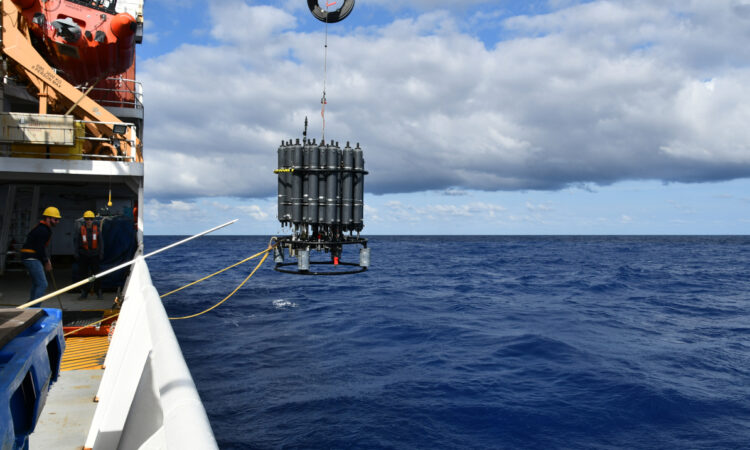Biden-Harris Administration invests $2.1 million for measuring surface ocean carbon through the Investing in America agenda

Today, the Department of Commerce and NOAA announced the award of $2.1 million to support surface ocean and atmospheric carbon observations and monitoring through President Biden’s Investing in America agenda. These funds from the Bipartisan Infrastructure Law will allow NOAA to expand a global network of sensors to track carbon dioxide in the ocean. They will also serve to improve the understanding and forecasting of global climatic and environmental changes.
“Thanks to President Biden’s historic Bipartisan Infrastructure Law, this investment of over $2 million will help NOAA continue leading the way on the vital work to observe and forecast the impacts of climate change globally,” said U.S. Secretary of Commerce Gina Raimondo. “It will also create innovative partnerships with private companies to improve carbon emissions tracking and strengthen the Biden-Harris Administration’s commitment to reduce atmospheric CO2 concentrations.”
Monitoring changes in surface ocean and atmospheric carbon dioxide (CO2) is key to understanding the impact of human-caused emissions on climate change and ocean health. The ocean naturally absorbs approximately a quarter of carbon dioxide released by fossil fuel burning and other human activities. This natural absorption reduces the amount of greenhouse gas emissions that remain in the atmosphere and contribute to climate change. However, the increase of concentration of CO2 in the ocean can also have negative implications for the broader marine ecosystems, notably ocean acidification.
“NOAA is once again proud to take a global leadership role in this important work, and proud to be one of the largest contributors of data to these multinational efforts,” said NOAA Administrator Rick Spinrad, Ph.D. “This monitoring initiative will help to address information needs and answer the urgent call to understand and assess the state of the world’s climate.”
The funds will allow NOAA’s Global Ocean Monitoring and Observing Program to deploy new CO2 sensors in climate-critical regions, helping to fill important data gaps in these undersampled areas. This effort is part of the Surface Ocean CO2 Reference Observing Network (SOCONET), a global network of automated measurements of atmospheric and surface ocean CO2 concentrations.
Monitoring efforts will provide policymakers with information on the global carbon cycle for climate negotiations and action. Tracking carbon in the ocean is an important component of NOAA’s broader efforts to understand the impact of greenhouse gases on climate. Monitoring and observing can also help experts to track the impacts to international ocean health — such as ocean acidification — and can inform ecosystem and fisheries management.
SOCONET will improve the ability to track carbon emissions and uptakes, which are essential for verifying the U.S. commitments to the United Nations Framework Convention on Climate Change Global Carbon Stocktake offsite link, the World Meteorological Organization Global Greenhouse Gas Watch (G3W) offsite link and the Paris Climate Agreement offsite link to monitor and reduce atmospheric CO2 concentrations.
These ocean carbon monitoring and observation projects will focus on assessing ocean regions that are essential for understanding the global carbon cycle. To do so, a new generation of carbon sensors with improved accuracy will be installed on a variety of novel platforms, such as cargo vessels, passenger cruise lines and research vessels, including NOAA Ship Ronald H. Brown and Saildrone autonomous surface vehicles.
Many commercial companies have shown interest in such activities in the past. Cruise ship companies, for example, have installed real-time displays that detail carbon levels in the ocean and atmosphere. These companies have also developed explanatory materials for passengers.
Increased data will improve the accuracy of climate forecasting tools. The measurements from ships and uncrewed surface vehicles will be recorded annually in the Surface Ocean CO2 Atlas (SOCAT), a global database with over 100 international contributors. The measurements will also be synthesized and used to estimate the amount of atmospheric CO2 that is absorbed by the ocean. Bipartisan Infrastructure Law funding will also modernize the SOCAT data submission tools and expedite the release of the SOCAT data sets, providing vital information for climate policy and ecosystem and fisheries management.
Visit the Bipartisan Infrastructure Law website to learn about current and future funding opportunities.
Climate, weather, and water affect all life on our ocean planet. NOAA’s mission is to understand and predict our changing environment, from the deep sea to outer space, and to manage and conserve America’s coastal and marine resources.






